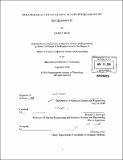Behavior of alloy 617 at 650°C in low oxygen pressure environments
Author(s)
Mas, Fanny (Fanny P.)
DownloadFull printable version (21.75Mb)
Other Contributors
Massachusetts Institute of Technology. Dept. of Materials Science and Engineering.
Advisor
Ronald G. Ballinger.
Terms of use
Metadata
Show full item recordAbstract
The behavior of alloy 617 at 650°C in low oxygen partial pressure environments has been studied under static loading. Of particular interest was the crack growth rate in these conditions. For that, tests were conducted at a constant stress intensity factor of 49.45 MPa'm (45 ksidinch) using a direct current potential drop measurement system to determine crack length. High purity argon gas allowed establishing an oxygen partial pressure as low as 10-22 atm and premixed oxygen/argon gases were used to vary the oxygen potential. To go dee er into the understanding of the phenomena involved, a creep test (constant load of 1.21x10 N in argon environment) and a corrosion experiment (50 ppm oxygen in argon for 500 hours without any load) were also added. The crack growth tests led to a particularly unexpected result: whatever the oxygen potential, the crack growth rate increased with time and the plot for the crack length versus time displayed a recurrent parabolic shape without any change in the environment. No unique crack growth rate could be defined in a given environment and the influence of the environment on the crack growth rate was not clearly visible. Multiple features were found to surround the main crack: secondary cracks parallel to the principal one, intergranular cracking ahead of the crack tip, wedge cracks at grain boundaries and aggregates of Cr-rich carbides near the lips of the crack. Moreover no extensive oxide scale was formed on the surface of the sample exposed to the corrosive environment (50 ppm oxygen in argon) for 500 hours. The non-constant crack growth rates, together with the observed cracking features, were attributed to the competition between creep deformation and mechanical fracture, likely environmentally enhanced. An exponential law was found to fit the data for the crack growth rate as a function of time for a K of 49.45 MPalm (45 ksi'inch). The effects of the environment were overcome by mechanical and thermal processes leading to damage accumulation and so, a reaction of alloy 617 to the external stress and temperature highly dependent on time. This behavior was compared with the one of alloys Haynes 230 and Incoloy 908 in the same conditions.
Description
Thesis (S.M.)--Massachusetts Institute of Technology, Dept. of Materials Science and Engineering, 2010. Cataloged from PDF version of thesis. Includes bibliographical references (p. 108-112).
Date issued
2010Department
Massachusetts Institute of Technology. Department of Materials Science and EngineeringPublisher
Massachusetts Institute of Technology
Keywords
Materials Science and Engineering.